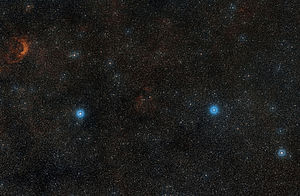HD 87643
 HD 87643 is embedded in the faint nebulosity at the centre of this image. The red arc is NGC 3199, aWolf–Rayet nebulaaround WR 18. | |
| Observation data EpochJ2000EquinoxJ2000 | |
|---|---|
| Constellation | Carina |
| Right ascension | 10h04m30.2840s[1] |
| Declination | −58° 39′ 52.091″[1] |
| Apparent magnitude(V) | 8.87[2](7.4 - 9.8[3]) |
| Characteristics | |
| Spectral type | B3 I[e][4] |
| U−Bcolor index | −0.54[2] |
| B−Vcolor index | +0.69[2] |
| Variable type | INA[3] |
| Astrometry | |
| Proper motion(μ) | RA:−7.557[1]mas/yr Dec.:+5.438[1]mas/yr |
| Parallax(π) | 0.6293 ± 0.1227mas[1] |
| Distance | approx. 5,000ly (approx. 1,600pc) |
| Absolute magnitude(MV) | −4.1[5] |
| Details | |
| Mass | 25[6]M☉ |
| Luminosity | 41,000[7]L☉ |
| Temperature | 17,000[7]K |
| Other designations | |
| Database references | |
| SIMBAD | data |

HD 87643is aB[e]classbinary starembedded in areflection nebula.
The system is described as having "one of the most extreme infrared excesses for this object class". It harbours a large amount of both hot and cold dust, and is surrounded by a debris disk with radius 2.5-3AU[6]and an extended reflection nebula. and is important forastronomersin their study ofstellar formation.[8]

All the properties of HD 87643 are highly uncertain. Its distance has been estimated anywhere from one to six kpc. TheGeneral Catalogue of Variable Starsclassifies it as anOrion variable,a pre-main sequence star, but other authors consider it to be a supergiant B[e] star. It has been confirmed to be abinary starsystem with the two stars separated by about 52 AU, but the nature of the companion is unknown.[8]
References
[edit]- ^abcdeVallenari, A.; et al. (Gaia collaboration) (2023)."GaiaData Release 3. Summary of the content and survey properties ".Astronomy and Astrophysics.674:A1.arXiv:2208.00211.Bibcode:2023A&A...674A...1G.doi:10.1051/0004-6361/202243940.S2CID244398875. Gaia DR3 record for this sourceatVizieR.
- ^abcMcGregor, P. J.; Hyland, A. R.; Hillier, D. J. (1988)."Atomic and molecular line emission from early-type high-luminosity stars".Astrophysical Journal.324:1071.Bibcode:1988ApJ...324.1071M.doi:10.1086/165964.
- ^abSamus, N. N.; Durlevich, O. V.; et al. (2009). "VizieR Online Data Catalog: General Catalogue of Variable Stars (Samus+ 2007-2013)".VizieR On-line Data Catalog: B/GCVS. Originally Published in: 2009yCat....102025S.1.Bibcode:2009yCat....102025S.
- ^Skiff, B. A. (2014). "VizieR Online Data Catalog: Catalogue of Stellar Spectral Classifications (Skiff, 2009-2016)".VizieR On-line Data Catalog: B/Mk. Originally Published in: Lowell Observatory (October 2014).1.Bibcode:2014yCat....1.2023S.
- ^Surdej, A.; Surdej, J.; Swings, J. P.; Wamsteker, W. (1981). "The Reflection Nebula Surrounding HD87643".Astronomy and Astrophysics.93:285.Bibcode:1981A&A....93..285S.
- ^abAltvater, Michael A.; Wu, Shuang; Zhang, Zhenyuan; Zhu, Tianhui; Li, Guohong; Watanabe, Kenji; Taniguchi, Takashi; Andrei, Eva Y. (2019). "Electrostatic imaging of encapsulated graphene".2D Materials.6(4): 045034.arXiv:1911.04114.Bibcode:2019TDM.....6d5034A.doi:10.1088/2053-1583/ab254e.S2CID189991060.
- ^abMillour, F.; Chesneau, O.; Borges Fernandes, M.; Meilland, A.; Mars, G.; Benoist, C.; Thiébaut, E.; Stee, P.; Hofmann, K.-H.; Baron, F.; Young, J.; Bendjoya, P.; Carciofi, A.; Domiciano De Souza, A.; Driebe, T.; Jankov, S.; Kervella, P.; Petrov, R. G.; Robbe-Dubois, S.; Vakili, F.; Waters, L. B. F. M.; Weigelt, G. (2009). "A binary engine fuelling HD 87643's complex circumstellar environment. Determined using AMBER/VLTI imaging".Astronomy and Astrophysics.507(1): 317–326.arXiv:0908.0227.Bibcode:2009A&A...507..317M.doi:10.1051/0004-6361/200811592.S2CID16463437.
